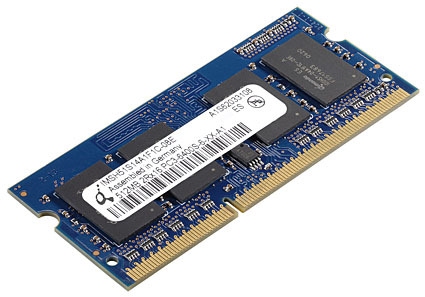Qimonda ships samples of DDR3 notebook memory
Munich (Germany) - Qimonda, a recently founded company that focuses on Infineon's former DRAM business, is first to announce sample shipments of DDR3 SO-DIMMs. The new notebook memory generation will be available in commercial systems sometime next year.
Following an aggressive and less than perfect plan to replace DDR with DDR2 memory, memory manufacturers came up with a much more careful roadmap to move towards DDR3. Originally scheduled for introduction in 2006, suppliers just started to supply the technology; for example, Elpida confirmed that it has been sending DDR3 modules since November of last year and Nanya said it plans to begin sampling sometime in the second half of this year. Qimonda, the world's second largest DRAM company, appears to be first to allow access to DDR3-based SO-DIMMs (Double Data Rate 3 Small Outline Dual In-line Memory Modules).
The firm said that it has supplied "the industry's first DDR3 SO-DIMM samples" to ATI. The modules have a capacity of 512 MB and are clocked at 800 MHz and 1067 MHz, which provides enough bandwidth to "transfer about 40 songs in MP3 quality or 80 high resolution digital images per second," according to the company. Qimonda believes that the first notebook PCs equipped with its DDR3 SO-DIMMs will become available in 2007.
"Qimonda's DDR3 memory module is the first SO-DIMM module operating on just 1.5 volts targeting a work day equivalent of battery time," said Thomas Seifert, member of the management board of Qimonda. According to the company, the reduction of supply voltage as well as a proprietary power saving technology will help to drop the power consumption of mobile computers.
Qimonda's DDR3 SO-DIMM
Memory suppliers at this time expect DDR3 production to be less important in 2007 and ramp substantially in 2008. Quoting DRAM Exchange, Qimonda estimates that DDR3 will make up about 30% of the total DRAM production in 2008 and replace DDR2 as the main volume product in 2009.
According to sources, Intel currently plans to introduce first DDR3-capable platforms in the second half of 2007. 800 MHz (DDR3-800) will be lowest initial clock speed of the memory when it hits the market; by 2009 1333 MHz is expected to be the mainstream speed of DDR3 memory.
Get Tom's Hardware's best news and in-depth reviews, straight to your inbox.
Related article:
Intel to introduce DDR3 memory platform in 2007
Tom's Hardware is the leading destination for hardcore computer enthusiasts. We cover everything from processors to 3D printers, single-board computers, SSDs and high-end gaming rigs, empowering readers to make the most of the tech they love, keep up on the latest developments and buy the right gear. Our staff has more than 100 years of combined experience covering news, solving tech problems and reviewing components and systems.

